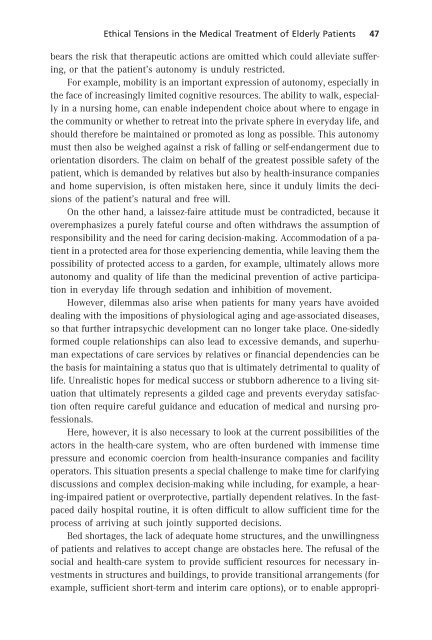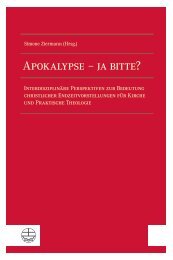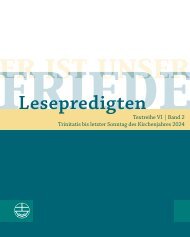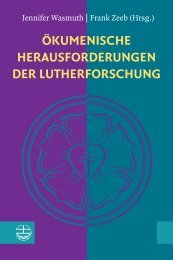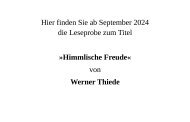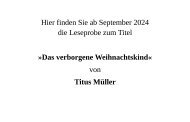Michael Welker | Eva Winkler | John Witte, Jr. | Stephen Pickard (Eds.): The Impact of Health Care (Leseprobe)
Pluralism has become the defining characteristic of many modern societies. Not only a plurality of individual and social claims and activities gain impacts on societal life. A creative pluralism of institutions and their norms profoundly shape our moral commitments and character – notably the family, the market, the media, and systems of law, religion, politics, research, education, health care, and defense. In the theoretical, empirical, and historical contributions to this volume, specialists on medicine, medical ethics, psychology, theology and health care discuss the many challenges that major transformations in their areas of expertise pose to the communication and orientation in late modern pluralistic societies. Contributors come from Germany, the USA and Australia.
Pluralism has become the defining characteristic of many modern societies. Not only a plurality of individual and social claims and activities gain impacts on societal life. A creative pluralism of institutions and their norms profoundly shape our moral commitments and character – notably the family, the market, the media, and systems of law, religion, politics, research, education, health care, and defense.
In the theoretical, empirical, and historical contributions to this volume, specialists on medicine, medical ethics, psychology, theology and health care discuss the many challenges that major transformations in their areas of expertise pose to the communication and orientation in late modern pluralistic societies. Contributors come from Germany, the USA and Australia.
Create successful ePaper yourself
Turn your PDF publications into a flip-book with our unique Google optimized e-Paper software.
Ethical Tensions in the Medical Treatment <strong>of</strong> Elderly Patients 47<br />
bears the risk that therapeutic actions are omitted which could alleviate suffering,<br />
or that the patient’s autonomy is unduly restricted.<br />
For example, mobility is an important expression <strong>of</strong> autonomy, especially in<br />
the face <strong>of</strong> increasingly limited cognitive resources. <strong>The</strong> ability to walk, especially<br />
in anursing home, can enable independent choice about where to engage in<br />
the community or whether to retreat into the private sphere in everyday life, and<br />
should therefore be maintained or promoted as long as possible. This autonomy<br />
must then also be weighed against arisk <strong>of</strong> falling or self-endangerment due to<br />
orientation disorders. <strong>The</strong> claim on behalf <strong>of</strong> the greatest possible safety <strong>of</strong> the<br />
patient, which is demanded by relatives but also by health-insurance companies<br />
and home supervision, is <strong>of</strong>ten mistaken here, since it unduly limits the decisions<br />
<strong>of</strong> the patient’s natural and free will.<br />
On the other hand, alaissez-faire attitude must be contradicted, because it<br />
overemphasizes apurely fateful course and <strong>of</strong>ten withdraws the assumption <strong>of</strong><br />
responsibility and the need for caring decision-making. Accommodation <strong>of</strong> apatient<br />
in aprotected area for those experiencing dementia, while leaving them the<br />
possibility <strong>of</strong> protected access to agarden, for example, ultimately allows more<br />
autonomy and quality <strong>of</strong> life than the medicinal prevention <strong>of</strong> active participation<br />
in everyday life through sedation and inhibition <strong>of</strong> movement.<br />
However, dilemmas also arise when patients for many years have avoided<br />
dealing with the impositions <strong>of</strong> physiological aging and age-associated diseases,<br />
so that further intrapsychic development can nolonger take place. One-sidedly<br />
formed couple relationships can also lead to excessive demands, and superhuman<br />
expectations <strong>of</strong> care services by relatives or financial dependencies can be<br />
the basis for maintaining astatus quo that is ultimately detrimental to quality <strong>of</strong><br />
life. Unrealistic hopes for medical success or stubborn adherence to aliving situation<br />
that ultimately represents agilded cage and prevents everyday satisfaction<br />
<strong>of</strong>ten require careful guidance and education <strong>of</strong> medical and nursing pr<strong>of</strong>essionals.<br />
Here, however, it is also necessary to look at the current possibilities <strong>of</strong> the<br />
actors in the health-care system, who are <strong>of</strong>ten burdened with immense time<br />
pressure and economic coercion from health-insurance companies and facility<br />
operators. This situationpresents aspecial challenge to make time for clarifying<br />
discussions and complex decision-making while including, for example, ahearing-impaired<br />
patient or overprotective, partially dependent relatives. In the fastpaced<br />
daily hospital routine, it is <strong>of</strong>ten difficult to allow sufficient time for the<br />
process <strong>of</strong> arriving at such jointly supported decisions.<br />
Bed shortages, the lack <strong>of</strong> adequate home structures, and the unwillingness<br />
<strong>of</strong> patients and relatives to accept change are obstacles here. <strong>The</strong> refusal <strong>of</strong> the<br />
social and health-care system to provide sufficient resources for necessary investments<br />
in structuresand buildings, to providetransitional arrangements (for<br />
example, sufficient short-term and interim care options), or to enable appropri-


